Boivin’s Unique Snow Hawk Innovation

AD Boivin’s Snow Hawk proved snow bike viability
A dozen years ago, AD Boivin’s Snow Hawk seemed like a strange and quite odd snowmobile whose unique design concept combined the snow world of sleds with the dirt world of off-road motorcycles. At the turn of the century AD Boivin, a boutique Quebec-based aftermarket manufacturer of snowmobile suspensions, created a snow vehicle that you rode through the snow like a motorcyle. It sat tall and you rode legs down like on a bike, not low with legs extended out as on a sled. It was tippy with only a single ski and narrow rear track and suspension. Instead of a dirt bike’s engine and gear box, the Boivin design featured a Rotax 503 fan-cooled twin cylinder working via a conventional CVT snowmobile transmission.
Unlike the modern snow bike concepts of Timbersled, which offers a conversion system of ski and rear suspension to integrate with an exisitng dirt bike, the Boivin Snow Hawk was designed as a single purpose snow vehicle, along the same idea as Arctic Cat’s proposed 2017 SVX 450.
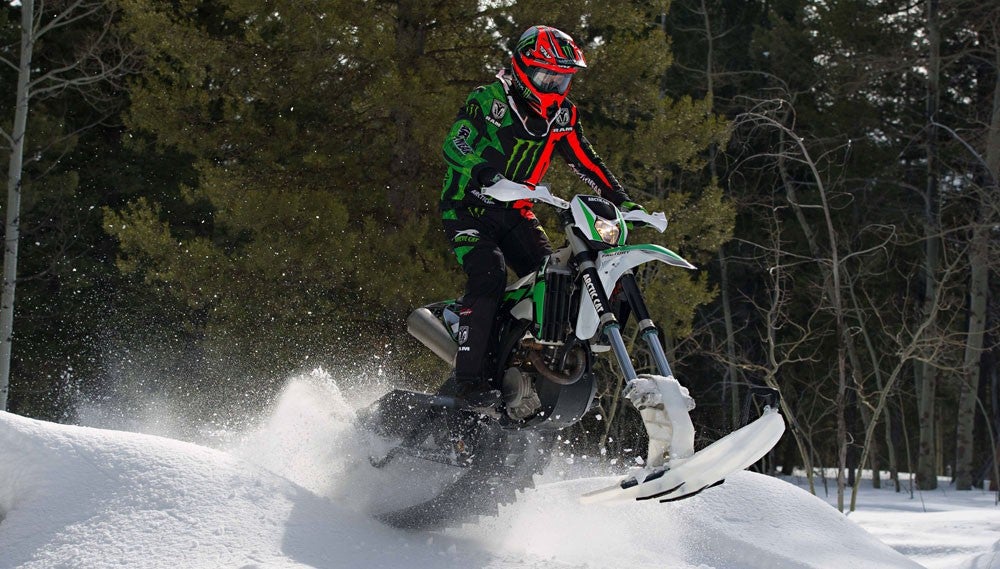
Like the Snow Hawk, Arctic Cat’s SVX 450 is built to be a dedicated sole purpose snow bike. Could the Snow Hawk reappear?
By model year 2005 the Snow Hawks swapped out the 55-horsepower fan-cooled twin in favor of a high performance, liquid-cooled Rotax 600 twin. It proved a significant leap in performance that would appeal to younger and more aggressive snow bike riders.

In the late 1990s, AD Boivin, a boutique Quebec-based snowmobile aftermarket manufacturer of snowmobile suspensions, created its first Snow Hawk, a special purpose one-ski snow bike powered by a fan-cooled engine and snowmobile transmission.
AD Boivin’s promotional materials suggested that the Snow Hawk 600HO offered the fun of its predecessor, but with twice the power! The company realized that power-to-weight made a difference in that fun quotient and Boivin laid claim to the best power-to-weight ratio in the snowmobile industry. A newly designed Twin-Axis Ski greatly enhanced handling, especially when used on hardpack snow.
As vintage riders are aware, snow bike concepts were not new and while most major snowmobile companies had researched creations of their own, only Chrysler Marine actually put a snow bike into production. In the early 1980s Chrysler Marine’s Sno-Runner was introduced as the first actual snow bike available for sale. It carried a low price, but that was about its only real virture as it proved to be an under-powered, ill-handling vehicle destined to become a unique collector’s item. Other than the fact that the Chyrsler was the first to use a single ski and track in a “bike” configuration, it shared little else with Boivin’s design. In its appeal, the Snow Hawk had more in common with stand-up personal watercraft like Kawasaki’s Jet-Ski than with sit-down snowmobiles.
Boivin’s Snow Hawk project got underway two years after the company began in 1995. The company experimented with the concept for four years before the first single-ski Snow Hawk was offered to the public. Its debut in August 2001 made AD Boivin the fifth global snowmobile manufacturer – behind Arctic Cat, Bombardier, Polaris and Yamaha. While Boivin would never generate the sales numbers of those four, its Snow Hawk found a small but steadily growing following among both snowmobile and dirt bike enthusiasts.
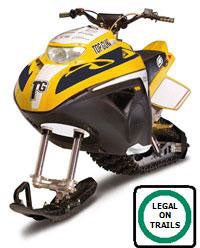
By 2008 the Snow Hawk market was declining and in May 2011 Boivin sold off iits Snow Hawk division to concentrate on its more popular Explorer snow bike kits, which allows consumers to convert their dirt bikes to seasonal snow bikes.
There was even a dedicated snow bike racing category in the World Snowmobile Association’s racing series, which created demand for the high performance Snow Hawk 600HO. By model year 2004, Boivin announced it was discontinuing the fan-cooled version because the company “…estimated that the potential market was too small to invest in a project to implement the 550F.”
Company president Denis Boivin explained, “We felt that because of customers’ expectations, the 600HO could become the base model and that it would be the only model available.”
Although the 600HO model proved successful, the volume was minor when considering the total number of snowmobiles being sold. Plus, AD Boivin already had other plans to design, develop, manufacture and market additional products for both motorsports and on-snow vehicles. It continued development of kits and suspension systems like its ETS (Energy Transfer System) and the Expert X suspension for performance snowmobilers.
By 2008 as demand for the Snow Hawk declined, Boivin developed the Explorer conversion system for motorcycles. This is more like the Timbersled kit and is a more affordable option for powersports enthusaists. With the commercial success of the Explorer, Boivin discontinued Snow Hawk production in 2008, eventually selling off the Snow Hawk division in May 2011 to Moto MST, ensuring a supply of parts for Snow Hawk customers.
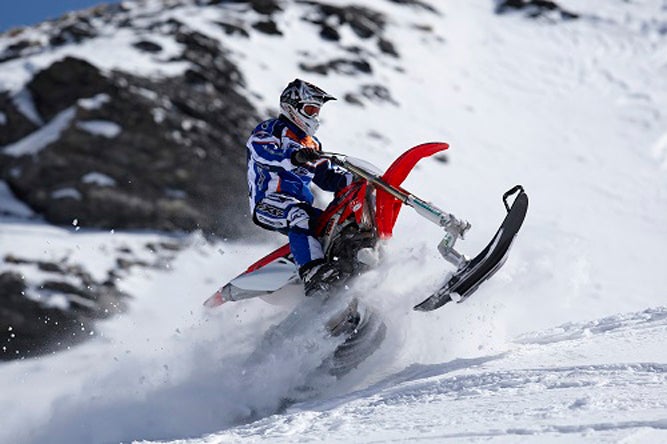
While Snow Hawk 600HO proved popular, it was never as versatile as Boivin’s Explorer, which is a conversion kit of ski and rear suspension that converts a dirt bike to snow use.
Through its experience with snowmobile suspension concepts and both its Snow Hawk and Explorer snow bike designs, Boivin gained invaluable knowledge of the track vehicle industry, creating a patented ATV track configuration that has seen use throughout the world. That product line was eventually sold to snowmobile and ATV track manufacturer Camoplast Solideal (now Camso).
The same thinking that led to the creation of the Snow Hawk is alive and well at AD Boivin, which created the unique and innovative Track N Go for use by full-size 4×4 vehicles. This concept converts a 4×4 from tires to tracks in under 15 minutes. Track N Go allows a vehicle to drive onto the conversion track unit where it is then secured for drive away. You have to view the YouTube videos (go to: www.trucktracks.com) to truly appreciate this clever concept.

Innovation plays a key role at AD Boivin as its unique and innovative Track N Go system proves. For use by full-size 4×4 vehicles, the Track N Go can convert a 4×4 from tires to tracks in under 15 minutes.
From Snow Hawks to Track N Go, Boivin still maintains a presence in the snow bike world with its Explorer conversion kit, which is said to fit most models of motocross or enduro bikes from 250cc and up. But, who knows, with the return of a dedicated sole purpose snow bike like Arctic Cat’s SVX, maybe the Snow Hawk could reappear. For now, though, the Snow Hawk will have to settle for being snowmobiling’s first true Snow Bike.
For more information, contact: AD Boivin Design Inc., Levis, Quebec G6V 9G6 (Visit: www.adboivin.com – Telephone: 418.838.3783).




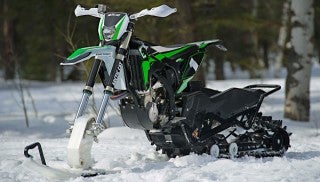
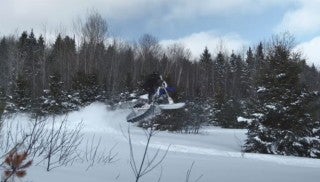


 Your Privacy Choices
Your Privacy Choices